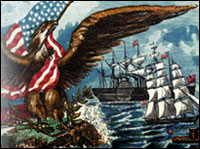You Must Be This Old to Govern
![[James Madison located bottom center] Painting, Close up of "Scene at the Signing of the Constitution of the United States," 1940, Howard Chandler Christy, Wikimedia Commons Painting, Close up of "Scene at the Signing of the Constitution of the United St](/sites/default/files/oldimage.jpg)
When writing the Constitution, how were the age requirements chosen for the specific posts? For example, one had to be 25 to become a representative.
Although at times the 1787 Constitutional Convention became bogged down in details, the delegates generally debated the “big picture” of crafting a new fundamental document for the United States. Given that bias for the larger topics, it is not surprising the delegates did not discuss at any length the age requirement for serving as a member of the House of Representatives, in the Senate, or as the President. What concerned them was not the age of the individual, but the quality of the representation provided to the people by those individual federal representatives.
During the convention, on May 29, 1787, Edmund Randolph of Virginia proposed what is now known as the Virginia Plan, originally drafted by James Madison. The fourth resolution stated: “that the members of the branch of the national Legislature ought to be elected by the people of the several States every for the term of ; to be the age of years at least . . .” Randolph and Madison left the specifics of elections and the ages of the members of the legislatures open for the convention to debate. Several weeks later, on June 22, the conversation in the convention turned to the issue of the election, length of service, and age of eligibility for members of the House. George Mason of Virginia rose and proposed 25 years of age as a qualification for the members of the first branch (House of Representatives). Mason’s motion passed seven states in favor, three opposed, and New York divided. Three days later, the convention took up Randolph’s resolution again, this time addressing the second branch (the Senate), and unanimously agreed to the clause requiring the age of members to be at least 30 years of age.
Since what most concerned the members of the convention were what Mason called “the danger of the majority oppressing the minority, and the mischievous influence of demagogues,” details such as the specific ages required to become representatives and senators did not rise to the level of major debate. Other issues were deemed far more important, such as how to elect the executive and the specific powers of the president, because of the controversial and dangerous nature of the proposed executive. The age requirements for president were included in the final recommendations that were agreed to by the Committee of Eleven (one member from every state). These required that the president be a “natural born citizen” at the time of the Constitution’s adoption, must have lived in the United States at least 14 years, and be no less than 35 years old.
Further evidence that the supporters of the proposed 1787 Constitution considered the issue of ages a detail can be found in the Federalist Papers. What concerned Publius (the pseudonym used by Alexander Hamilton, James Madison, and John Jay) was not the age of the representatives (mentioned only in passing in Federalist 51-54), but the timing and frequency of elections to maintain accountability to the people in the states. Biennial elections allowed representatives to reflect the changing moods of the electorate at home while providing institutional stability in the House.
The Federalist Papers also address requirements for office. In Federalist 62, Publius examines the constitutional requirement for becoming a senator. Again, it was not the age of the individual that mattered so much as the length of residency in the country and the individual’s level of maturity. The differing requirements for Senate (vs. House of Representatives), Publius wrote, “is explained by the nature of their senatorial trust; which requiring greater extent of information and stability of character, requires at the same time that the senator should have reached a period of life most likely to supply these advantages.” So too with the proposed presidency; Publius argues in Federalist 67-71 that the older age was needed because of the burden, trust, and perspectives needed in an executive.
Thus, while it would be wrong to say that the members of the Federal Convention assigned the ages haphazardly, it would also be wrong to say that they spent much time debating the virtues of 25, 30, and 35 years old to hold federal elected office. Rather, they followed the patterns already established in the states, and they increased the ages as the importance and burdens of federal office increased.
Read an article by the United States Senate on the issue.
Berkin, Carol. A Brilliant Solution: Inventing the American Constitution. New York: Harcourt, 2002.
Farrand, Max. The Framing of the Constitution of the United States. New Haven: Yale UP, 1913.
Notes of Debates in the Federal Convention of 1787 Reported by James Madison. New York: W.W. Norton, 1966.
The Federalist. Edited by J. R. Pole. Indianapolis: Hackett Publishing, 2005.


